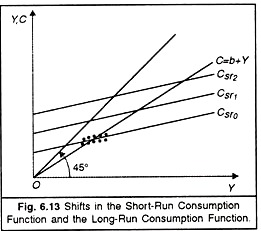The below article provides quick notes on the Absolute Income Hypothesis.
Under the absolute income hypothesis, consumption is determined by the absolute level of income.
Thus, the basic relationship between consumption and income is the short-run consumption function.
For example, if aggregate consumption is plotted against aggregate income for, say, a ten-year period and a line is fitted to the points, the line will be relatively flat and intersect the vertical axis at a positive level of consumption. Line C sr0 in Figure 6.13 is such a line.
If other ten-year spans were considered, a series of short-run consumption functions would be obtained. If, however, data for the entire time span arc plotted and a line fitted to the points, the line passes through the origin (or very close to it) and is relatively steep. This line represents the long-run consumption function. Thus, the shifts in the relatively flat short-run consumption function give the impression of a relatively steep long-run consumption function.
ADVERTISEMENTS:
The consumption function is alleged to shift upward for a variety of reasons. It may shift because of migration from rural to urban areas. Apparently, city dwellers consume a higher proportion of their income than persons who live in rural areas. Consequently, migration from rural to urban areas tends to increase consumption even in the absence of an increase in income.
Another reason for these upward shifts in the consumption function has to do with the introduction of new products. The introduction of new goods, it is claimed, stimulates consumption as these goods come to be regarded as essential for the good life. If this is true, a steady procession of new goods produces upward shifts in the consumption function.
James Tobin has argued that the short-run consumption function shifts upward over time because of increases in the nation’s wealth. By wealth, Tobin means liquid assets, mainly cash, bank deposits, and savings bonds. He argues that an increase in asset holdings, all other things bring equal, increases consumption. Consequently, he believes that the growth of the nation’s asset holdings, along with income, may have been sufficient to account for the upward shifts, hence the constancy of the average propensity to consume over time.
ADVERTISEMENTS:
Thus, proponents of the absolute income hypothesis argue that the basic function is the short-run function and that the long-run function is produced by upward shifts in the short-run function. Presumably, if the factors that cause the upward shifts in the short-run function were to remain constant or cease to be important, only the short- run consumption function would be observed.